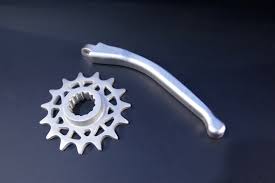Metal 3D Printing on the Desktop Heats Up

Stainless steel 3D-printed part made on a Desktop Metal Studio system, undergoing dual-stage sintering. (Image courtesy Desktop Metal)
Latest News
August 29, 2017
 Percentage breakout by type of metal chosen for industrial 3D printing projects, averaged over past two years of parts procured through 3Diligent. New metal systems targeted to the office environment will soon enter this market. Interestingly, no single metal alloy is dominant. (Image courtesy 3Diligent)
Percentage breakout by type of metal chosen for industrial 3D printing projects, averaged over past two years of parts procured through 3Diligent. New metal systems targeted to the office environment will soon enter this market. Interestingly, no single metal alloy is dominant. (Image courtesy 3Diligent)Whether you say “desktop metal” or Desktop Metal, this sub-topic of 3D printing is hot and getting hotter. Ever since the first metal additive manufacturing (AM) systems made 3D printing with metal materials possible, developers have worked to make variations on the technology smaller, faster, safer, less expensive and easier to manage.
(Editor’s note: An earlier version of this article mistakenly attributed the first metal additive manufacturing (AM) systems to DTM (now part of 3D Systems. DTM’s sintering process created masters for lost-wax casting in metal, but did not ever directly use metal powder.)
Vendors have made progress on every one of these goals, but for almost three decades the systems still required operating in a highly controlled, industrial environment. Limiting factors include: Raw metal powders present inhalation and explosion risks, and the complete build process generally includes post-build machining and heat-treatment (i.e., adding wire-EDM machines and industrial furnaces).
Fast-forward through the past eight months. The industry has seen metal 3D printing announcements from both Markforged (January) and Desktop Metal (May). These office-friendly AM systems avoid the concerns posed by working with classic powdered-metal materials. At a top level, both approaches use plastic-encapsulated powders and extrusion systems, and are expected to produce parts at around one-tenth the cost of laser powder bed 3D Printing. What could this mean for you?
Game-Changer for Metal 3D Printing
3Diligent, an online manufacturing service that provides rapidly manufactured parts to customers, has its eye on the implications of these systems. Through its web portal, the company offers 3D printing, CNC machining, casting, and molding services for all stages of product development. Cullen Hilkene, 3Diligent CEO and co-founder, has watched the metal AM world expand beyond aerospace and medical users to include automotive, industrial, and consumer applications, and sees significant potential for the new desktop-metal approaches.“I think we will see opportunities for these new technologies,” says Hilkene, “especially in industries where certain (metal part) requirements like tolerances, porosity and surface finish aren’t as stringent. I think you can draw parallels between the plastics market and the metals market. In plastics AM, you have powder bed and extrusion, and both have advantages.”
 Stainless steel 3D-printed part made on a Desktop Metal Studio system, undergoing dual-stage sintering. (Image courtesy Desktop Metal)
Stainless steel 3D-printed part made on a Desktop Metal Studio system, undergoing dual-stage sintering. (Image courtesy Desktop Metal)Both new systems — the Metal X from Markforged and Studio from Desktop Metal (the latter company also announced a Production metal system based on a different process) — comprise a desktop 3D printer, some type of washing station (to partially remove the plastic binder that encapsulates the powdered metal) and a two-stage sintering furnace (microwaves plus heat).
 Sprocket gear and internally detailed lever both 3D-printed on a Markforged Metal X office-environment system. (Image courtesy Markforged)
Sprocket gear and internally detailed lever both 3D-printed on a Markforged Metal X office-environment system. (Image courtesy Markforged)Markforged’s process is called Atomic Diffusion Additive Manufacturing (ADAM) while Desktop Metal has developed the Bound Metal Deposition (BDM) approach. Operating software controls the print process to plan ahead for shrinkage; about 20% is standard for the 17-4 PH and 316L steels that are among the first available materials. (Desktop Metal says it can already handle copper, Inconel, H13 tool steel and others; Markforged says it has similar materials working or in beta, and both companies say aluminum and titanium will be coming.) Both systems are priced to start around $120K, and will start shipping within a month.
How Metal 3D Printing May Shine on the Desktop
“For some low volume applications,” says Hilkene, “the cost of a mold or printing with powder bed fusion is prohibitive and binder jetting with metal infiltration isn’t viable on account of time or material properties. Typically, machining is the answer in these situations, but this is where a desktop metal AM approach might make a big impact, offering tool-less, cost-effective production for low volume metal parts.”When viewing the larger AM market, additional comparisons come to mind. “The entry of these systems reflects a broader trend,” notes Hilkene. “We’re seeing new approaches and machines as 3D Printing transitions from modeling to functional prototyping to production technology. It’s happening in the plastics market with new arrivals Carbon and HP joining industry veterans Stratasys, 3D Systems, and Envisiontec. The same looks to be happening in the metals market, with these companies and others expanding the capability and accessibility of metal printing.”
While Hilkene emphasizes that it’s difficult to know the impact of these new metal 3D printing machines until both company’s systems are really on the market, it’s clear that desktop metal systems could close a product-development gap that has existed for 30 years.
For more insight from 3Diligent on the market for industrial AM in general and metals in particular, check out these company white papers: 3Diligent State of Professional Industrial 3D Printing and 3Diligent Complete Guide to Metal 3D Printing.
Subscribe to our FREE magazine, FREE email newsletters or both!
Latest News
About the Author
Pamela Waterman worked as Digital Engineering’s contributing editor for two decades. Contact her via .(JavaScript must be enabled to view this email address).
Follow DE





